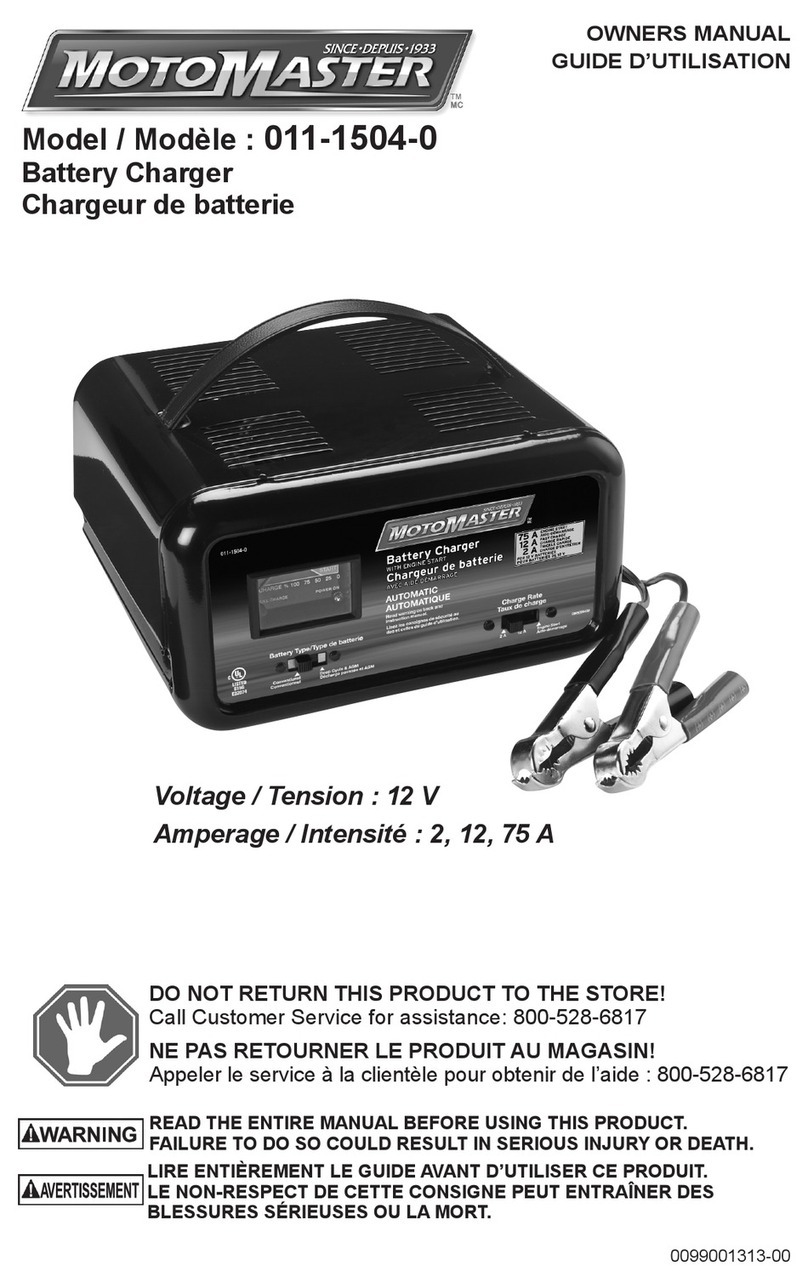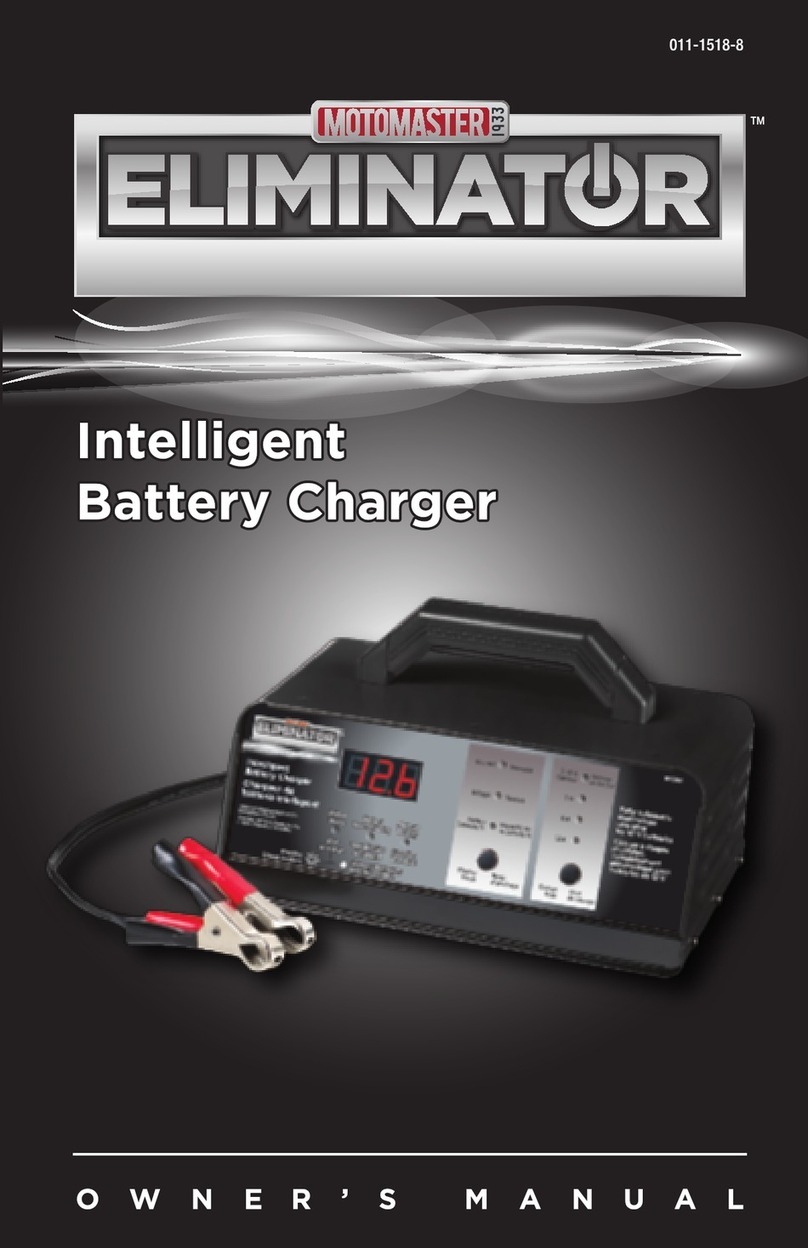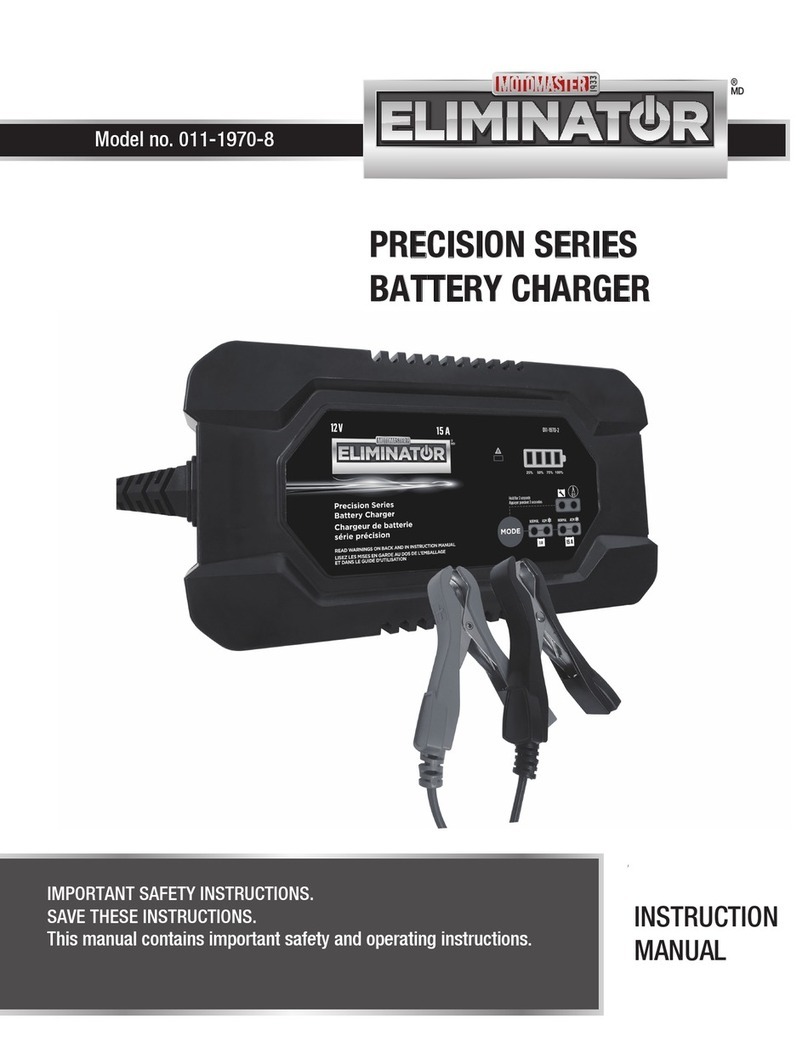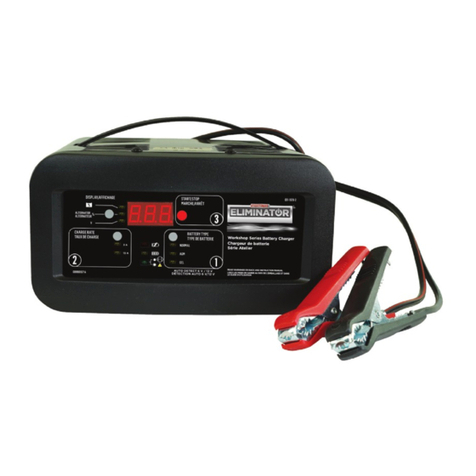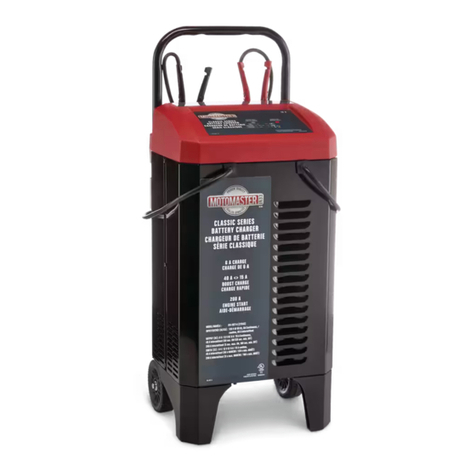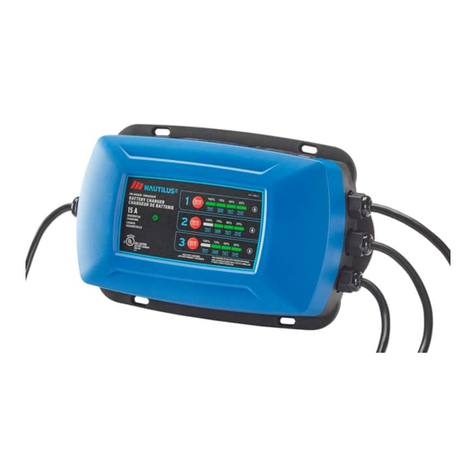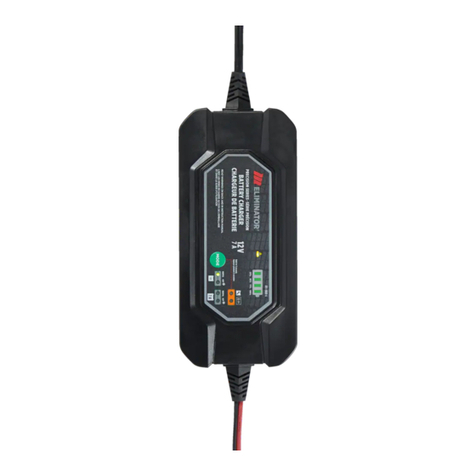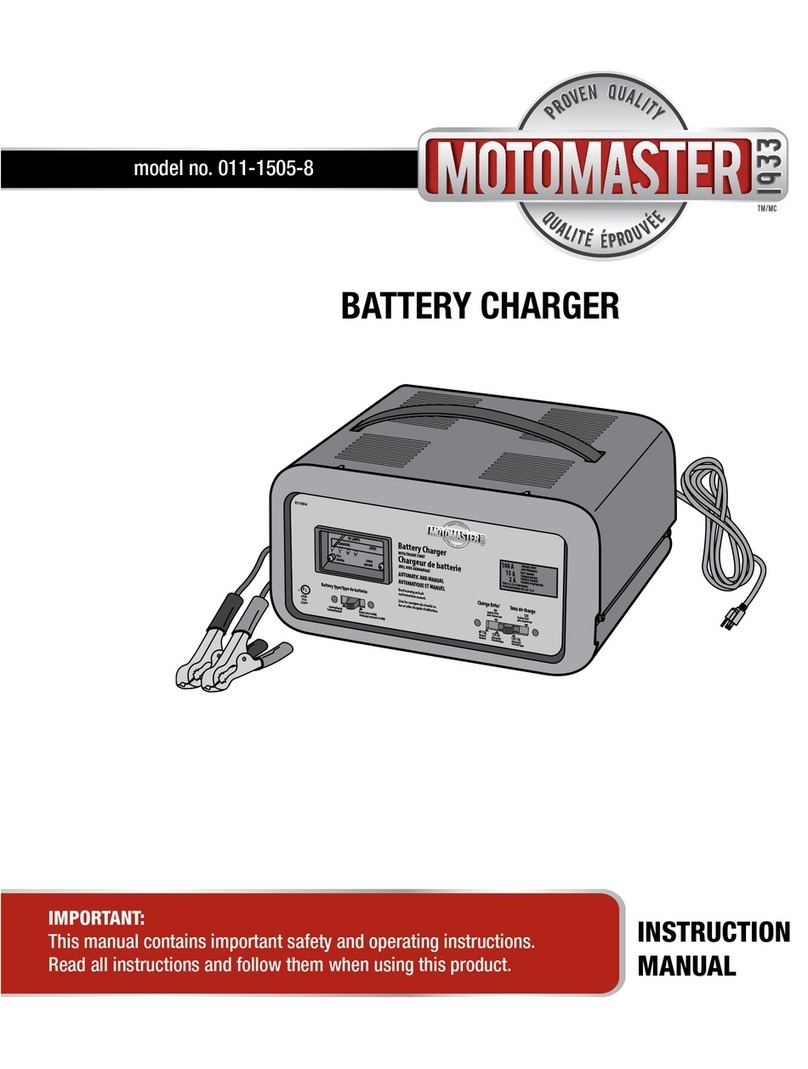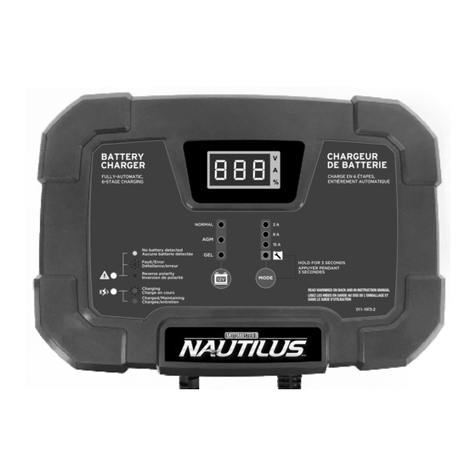
5
headline bars
continuation tabs
headline bars
continuation tabs
notes
warnings
headline bars
continuation tabs
notes
warnings
Model no. 011-1971-6 Questions? Contact us 1-888-942-6686
4
INTRODUCTIONSAFETY
INTRODUCTION
IMPORTANT SAFETY INSTRUCTIONS
WARNING—RISK OF EXPLOSIVE GASES.
PERSONAL SAFETY INSTRUCTIONS AC ELECTRICAL CONNECTIONS
PLUGGING CHARGER IN
USING AN EXTENSION CORD
MINIMUM RECOMMENDED EXTENSION CORD
PREPARING TO CHARGE
SAVE THESE INSTRUCTIONS.
SAFETY
The MotoMaster Eliminator Precision Series 3-
Bank Battery Charger features advanced
technology that makes battery charging faster,
easier, and safer while helping to maximize
the performance and life of your batteries.
This battery charger is designed for use on all
types of 12-volt lead-acid batteries including
Wet (flooded), Maintenance-free (MF), Calcium
(Ca), Enhanced Flooded (EFB), Absorbed Glass
Mat (AGM), and Gel. It is suitable for charging
batteries from 5 to 25 Amp-hours and
maintaining batteries from 5 to 500
Amp-hours.
This manual will explain how to use the charger
safely and effectively. Please read and follow
these instructions and precautions carefully.
Read all instructions, warnings, and
cautions printed on the battery charger,
battery and vehicle or equipment using
battery.
DO NOT expose charger to rain or snow.
Use of an attachment not recommended or
sold by the battery charger manufacturer
may result in a risk of fire, electric shock,
or injury to persons.
To reduce risk of damage to electric plug
and cord, pull by plug rather than cord
when disconnecting charger.
An extension cord should not be used
unless absolutely necesssary.
Use of an improper extension cord could
result in a risk of fire and electric shock. If
an extention cord must be used, make
sure:
•
•
•
•
•
The pins on plug of extension cord
are the same number, size, and
shape as those of plug on charger.
The extension cord is properly wired
and in good electrical condition.
The wire size is larger enough for the
AC ampere rating of the charger, as
specified in the chart on the following
page.
DO NOT operate charger with damaged cord
or plug—replace the cord or plug immedi-
ately.
DO NOT operate charger if it has received a
sharp blow, been dropped, or otherwise
damaged in any way; take it to a qualified
serviceman.
DO NOT disassemble the charger. Take it to
a qualified service professional if service or
repair is required. Incorrect assembly may
result in fire or electric shock.
To reduce risk of electric shock, unplug
charger from outlet before attempting any
maintenance or cleaning. Turning off controls
will not reduce this risk.
•
Consider having someone close by to come
to your aid when you work near a lead-acid
battery.
Have plenty of fresh water and soap nearby
in case battery acid contacts skin, clothing,
or eyes.
Wear complete eye protection and clothing
protection. Avoid touching eyes while
working near battery.
If battery acid contacts skin or clothing,
wash immediately with soap and water. If
acid enters eye, immediately flood eye with
running cold water for at least 10 minutes
and get medical attention immmediately.
NEVER smoke or allow a spark or flame in
vicinity of battery or engine.
Take extra precautions to avoid dropping a
metal tool onto the battery. It may spark or
create a short circuit that can cause an
explosion.
Remove personal metal items such as
rings, bracelets, necklaces, and watches
when working with a lead-acid battery. A
lead-acid battery can produce a short-
circuit current high enough to weld a ring
or the like to metal, causing a severe burn.
Use charger for charging a lead-acid
battery only. It is not intended to supply
power to a low voltage electrical system
other than in a starter-motor application.
Do not use battery charger for charging
dry-cell batteries that are commonly used
with home appliances. These batteries may
burst and cause injury to persons and
damage to property.
NEVER charge a frozen battery.
Your charger requires a 120 V AC electrical
wall outlet receptacle installed according to
local codes and ordinances.
An extension cord should not be used
unless absolutely necessary. Use of
improper extension cord could result in a
risk of fire and electric shock. If an
extension cord must be used, make sure:
•
The pins on plug of extension cord are the
same number, size, and shape as those of
plug on charger.
The extension cord is properly wired and in
good electrical condition.
The wire size is large enough for AC
ampere rating of charger as specified in the
chart below:
•
•
•
•
•
•
•
•
•
•
•
•
•
•
•
•
WORKING IN THE VICINITY OF A LEAD-
ACID BATTERY IS DANGEROUS. BATTER-
IES GENERATE EXPLOSIVE GASES
DURING NORMAL BATTERY OPERATION.
FOR THIS REASON, IT IS OF UTMOST
IMPORTANCE THAT YOU FOLLOW THE
INSTRUCTIONS EACH TIME YOU USE THE
CHARGER.
To reduce risk of battery explosion,
follow these instructions and those
published by battery manufacturer and
manufacturer of any equipment you
intend to use in the vicinity of the battery.
Review cautionary markings on these
products and on engine.
•
•
•
•
Length of Cord, Metres (Feet) AWG* Size of Cord
7.6 (25) 18
15.2 (50) 18
30.5 (100) 18
45.6 (150) 16
*AWG = American Wire Gauge
®
If it is necessary to remove battery from
vehicle to charge, always remove grounded
terminal from battery first. Make sure all
accessories in the vehicle are off so as not
to cause an arc.

